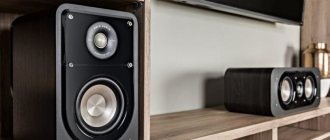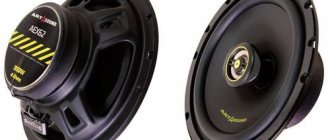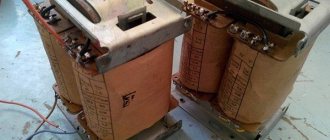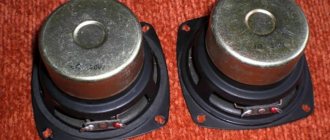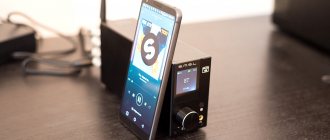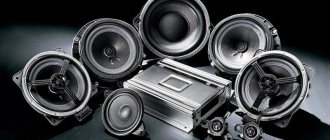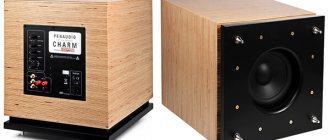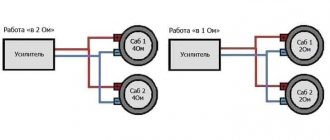So, the time has come to replace the speakers in the car. How to do this, and what do you need to know for this? You definitely need to understand the number of speakers you are replacing, their size, the power that the tape recorder or amplifier will provide (when installed), and the desired power rating of the speakers. It would also be good to understand where to connect which ones.
How to connect?
How to choose 16 cm speakers for your car
All car acoustics come in three types:
- Broadband
- Coaxial
- Component
The first type of speakers is a single emitter that reproduces the frequency band specified in the characteristics relatively linearly. Such speakers cannot provide deep bass and very high frequencies. This is due to the design of the diffuser, which is designed to reproduce the mid-range sound range. The best 16 cm speakers for a car operate in the band from 40-50 Hz to 14-16 kHz, with slight blockages at the edges of the range.
Coaxial acoustics consists of several dynamic heads, which are placed in the center of the main loudspeaker. The most common models are made on the basis of a broadband loudspeaker, in the center of which a high-frequency tweeter is installed. The best 16 cm coaxial speakers can include more acoustic drivers, and the acoustics become multi-band. Component speaker systems for cars are considered to be of the highest quality, as they consist of several individual emitters that are optimally positioned to obtain high quality sound. Passive LC filters are used to divide the audio range into separate frequency bands.
Rating of 16 cm speakers for cars
The rating of the best 16 cm speakers for cars is compiled based on technical characteristics and reviews from car enthusiasts about specific models. Car acoustics are evaluated in different categories, since the parameters of a coaxial system differ from wideband and component acoustics. To figure out which 16 cm speakers are best for a car, you need to know their main technical characteristics. These include the following data:
- Playable frequency band
- Rated power
- Peak power
- Resonance frequency
- Voice coil resistance
When purchasing loudspeakers from unknown manufacturers, you need to know that the technical characteristics may be greatly inflated or indicated incorrectly, so you should always read the reviews of car enthusiasts.
Often car enthusiasts, buying expensive and high-quality emitters, then complain that they cannot obtain high-quality sound. This is usually due to improper installation and fastening of the acoustics, lack of noise suppression, and too much power supplied to the emitter.
The best coaxial 16 cm speakers for cars
Coaxial speaker systems have become widespread among car enthusiasts. They take up little space and can be placed anywhere in the car interior. The best 16 cm speakers for cars are connected through a simple crossover filter. If desired, you can choose not two-way coaxial acoustics, but a system with a division into 3-4 bands.
- HERTZ DCX 165.3
- JBL GT7-6
- ALPHARD AL-165T
The best 16 cm coaxial speakers for cars are considered to be American products.
These speakers provide high sound quality in both low and high frequencies. They can be connected without an amplifier, directly to a music center, but in this case the bass reproduction will be weak. These speakers are often used as front speakers and installed in the front doors of a car.
The JBL GT7-6 acoustics are reliable and have good build quality. The speakers have high sensitivity (93 dB), which allows them to be used without ULF. The diffuser, made of polypropylene, can withstand heavy loads, which ensures high operational reliability.
The Alphard AL-165T speakers have a frequency response that is linear from 35 Hz to 25 kHz. The 16 speakers with good bass can be used without an amplifier, but the volume will seem insufficient. The system provides powerful bass that rivals a subwoofer, and the tweeter produces clear and sonorous high frequencies.
Number of speakers in the car
Should you put 2 speakers or 4 speakers in your car, or maybe 6? The purity of sound is determined by the quality of the speakers, not their quantity. Many car owners are limited to two mid-frequency component speakers in the front doors and tweeters on the pillars, while a subwoofer is placed in the back, which plays low frequencies. Thus, the entire spectrum of sound in the car is revealed.
Also popular is the option of installing 4 coaxial speakers, 2-3 way in the front doors, 3-4 way in the rear parcel shelf. The number of speakers that can be installed is limited only by the size of the car and the desire of its owner. At various car audio competitions you can see cars with dozens of speakers installed throughout the car. 2 speakers in the front doors may well be enough for you, it all depends on your musical preferences.
Connection
When replacing speakers or installing new ones, pay attention to the quality and condition of the wiring. Thin wires with twisted connections are not capable of transmitting sound efficiently and without loss. There is special wiring for transmitting the audio signal - it is a multi-core copper or silver shielded cable.
For clear and high-quality sound, installation of such wiring is necessary. Pulling new wires to replace the old ones is quite simple; tie a new cable to the end of the old wiring and carefully pull it through the other end of the wire. During the connection process, it is very important not to confuse the polarity; the wide terminal on the speaker is the positive contact.
When connecting speakers through an amplifier, the wiring from the radio is stretched to the location of the amplifier, and from it diverges to the speakers. The amplifier's power wires should not be pulled together with the audio wiring; it is advisable to space them away from each other, this way you can avoid interference from pickup. The amplifier heats up during operation; free space is required for its normal cooling.
It is important not to forget to connect the audio system through a fuse, the power of which is calculated using the formula “Output power / 12 volts = number of amps of the fuse.” For example, 4 speakers are installed, 40 W each /12 = 13.3, we install a 15A fuse.
Best 16cm Component Speakers
Component acoustics consists of several loudspeakers and a passive filter to separate the audio frequency range. Most often, good 16 cm speakers for a car without an amplifier consist of a full-range speaker with high-frequency limitation and a tweeter. The places for the emitters in the car interior are chosen in such a way that the sound picture is as clear and better as possible. The top speakers and 16 cm speakers for cars are headed by the Japanese acoustics Pioneer TS-170Ci. The system perfectly transmits the entire sound range, but to obtain the best sound quality it must be connected to an amplifier.
The system is perfectly installed in standard seats of different cars. Thanks to their small thickness, which does not exceed 5.9 cm, the speakers can be easily mounted in the front doors of the cabin without installing an additional podium. The rating of 16 cm speakers in cars continues with the JBLCS760C acoustics. The main driver produces pronounced low frequencies that harmonize well with the central band of the audio range. The crossover allocates a frequency band for the tweeter, which reproduces them clearly and without distortion. The system can withstand power overloads without creating audible distortion. Typically these speakers are mounted in the front doors of the passenger compartment.
They are installed without any modifications. Budget 16 cm speakers with good sound include the NAKAMICHINCE - CS 1617 system. These high-quality acoustics provide clear sound with good low frequencies and light glass “tops”. It is noted that directly connecting the speakers to a music center without an amplifier does not produce deep bass, but reproduces the middle of the sound range well. Acoustics are afraid of overloads, so its operation at critical power levels is not recommended. The best 16 cm component speakers are often used by car enthusiasts to replace standard speakers.
Denial of responsibility
First of all, this should note that if you have weak speakers, sub-par or partially blown speakers, none of the tips below will make any noticeable difference.
The tips we've listed here assume you have decent speakers in your car.
Plus, if you want your music to be loud—really loud—amps are definitely part of the picture. Whether you want to make the sound louder or lower, like great background music, a power amplifier will bring your music to life, bringing out all the excitement and detail.
With that said, having an amplifier is never a bad idea. No amount of tips or tricks can miraculously improve sound quality and make your speakers louder than your amplifier. However, there are some great tips that can give you noticeable results. And since you're here, we're guessing that's exactly what you're looking for. So let's get started...
Which 16 cm speakers are better for the front?
Front speakers are considered the most important part of a car's complex sound system. 16cm speakers without an amplifier will provide the full audio range, but the bass will be slightly weaker, so a low-frequency amplifier will be required for deep and rich bass. However, there are speaker models that are characterized by increased bass response. If we compare acoustic heads by the diameter of the emitter, then there is a direct relationship: the larger the diameter of the emitter, the lower frequencies it can reproduce. Therefore, you need to choose 16 cm models as front speakers. It is difficult to name the best 16 cm speaker, but many positive reviews apply to the CHALENGERPWR 16.2 acoustics.
This is a two-way component acoustic system consisting of two heads and a crossover. The system has a sensitivity of 92 dB and a rated output power of 100 watts. The linear frequency response starts from 40 Hz. These are good speakers 16 in the car and are suitable as a front system.
What are the best 16 cm midrange speakers?
Wideband or midrange speakers are used as budget acoustics. They are easy to install and connect, but the playback quality will be slightly worse than that of coaxial and component systems. Good 16.5 SMS speakers with good bass will ensure normal reproduction of low frequencies even when directly connected to a music center without an amplifier. Among mid-frequency drivers, the top 2022 16 cm speakers in a car are as follows:
- Hertz
- Swat SP
- Morel
- Kicx
Hertz loudspeakers are the undisputed leader in playback quality and assembly, but many car enthusiasts prefer Morel speakers. They are distinguished by an extended reproduction range in the direction of high frequencies. Which speakers 16 for a car are best to buy depends on your financial capabilities. The midrange speakers from the list are of approximately the same quality and differ only in price.
What are good 13 cm speakers?
- 1 JVC CS-J510X. Best Sound Quality
- 2 Focal RCX-130. High-quality reproduction of low frequencies...
- 3 Alpine SXE-1325S. High sound purity...
- 4 JBL CS752. The most durable diffuser...
- 5 Hertz DCX 130.3. The loudest acoustic effect...
- 6 Mystery MJ 550. Optimal sound quality...
- 7 Pioneer TS-R1350S. ...
- 8 Ural AS-C1327K. ...
THIS IS INTERESTING: Best answer: What kind of oil should I fill in the Skoda Octavia 1 4 TSI?
Best Budget 16cm Speakers
High-quality car audio requires a lot of expense, but even on a modest budget you can build a good quality sound system. One of the best models is JBLGT-652. At a low cost, the acoustics produce clear and well-balanced sound. The lows are well defined and the midrange doesn't blur together, with every tone sounding very distinct. Coaxial speakers with a nominal power of 45 watts and an impedance of 4 ohms have a sensitivity of 93 dB. This group includes Morel Maximo 6 speakers. Unlike JBL, this is a component system consisting of two high-frequency tweeters, two mid-bass speakers, crossovers and mounting hardware.
Acoustics Morel Maximo 6 is considered the best 16.5 cm speakers.
What is the best power rating for 16 speakers?
This issue has always been controversial among car enthusiasts. Some choose acoustics for maximum power when the sound level in the cabin reaches the pain threshold. Others prefer high and clear reproduction quality. For 16 cm emitters, the normal power is considered to be 45-70 watts. Such power will allow you to provide high-quality sound for the interior of any car. The main thing when choosing acoustics is that its power exceeds the output power of the music center or amplifier. It is desirable that this parameter differ by a factor of two. So, with an amplifier output power of 100 watts per channel, the optimal power of the speaker system should be at least 150-200 watts.
Car audio is a topic that is seriously addictive. Exactly a month ago I knew nothing at all about car audio except the words “bass” and “pumps”. Now I can already carry on a conversation about amplifiers, tweeters, coaxials and crossovers. This material may be a useful brief excerpt from other sources for those who have just begun to study car audio for their middle-class Logan car, but most likely of little interest to those who have been interested in car audio for a long time.
As sources of information I recommend: 1.Book. Available on torrents.
Usually people start immersing themselves in music either a) from the head (head unit), or b) from a free subwoofer or amplifier.
But it’s worth starting with the choice of layout.
So, possible layout options:
1. A simple and low-cost circuit without an amplifier: two-way front and one-way “playing along” from the rear.
(i)Very simple, but very important things to understand: for good music reproduction, always separate the mid-bass speaker from the tweeter, because According to the laws, there is no universal speaker that would play equally well over the entire frequency range.
To add drive, you should add bass to ordinary music. To do this, you can add bass in the trunk to the budget scheme. Since the power of the head unit is not enough for high-quality operation of the subwoofer, we will need to use an amplifier:
(i) A common mistake for Logan: using rear speakers in the shelf along with a subwoofer in the trunk. Bad manners (bad manners), because sound is nothing more than a sound wave (a wave of discharged and compressed air) and for the speaker to work normally it needs air and a certain working volume. When we place several speakers in one working volume (in a Logan, the rear speakers and subwoofer will use one trunk volume), the wave from the subwoofer will “kill” all the sound of the rear speakers, constantly confusing them and swinging them out of step with the bass. Thus, we will listen to the bass with a “clogged” and destroyed sound from the rear speakers. Music lovers and audiophiles are very against it. Therefore, the above scheme only works when 1) the rear speakers are in the side pillars or rear doors and do not use the trunk, or 2) the subwoofer faces into the cabin and uses its own closed box, and not the trunk of the car.
Actually, it is precisely because of the design feature of the sedan (the location of the speakers in the rear parcel shelf) that the following scheme without “backing vocals” is popular:
By and large, rear speakers are not always needed; the classic audio system is the “front plus subwoofer” circuit. Therefore, if you are not going to build a complex system, you can sacrifice the rear, but in return get higher sound quality from the front speakers. In such a scheme, all four channels of the built-in amplifier will work only at the front, forming a so-called channel-by-channel amplification scheme using passive crossovers of the speaker systems themselves.
Car audio for dummies
First, let's look at the characteristics that are indicated in the passport.
Input sensitivity - the higher the sensitivity, the better the speakers will play without an amplifier.
The reproduced frequency range is the frequency band in which the acoustics reproduce sound. There are broadband (for systems without a crossover), high-frequency, mid-frequency and low-frequency.
Impedance is the electrical resistance of a speaker.
Rated electrical power is the power that the speaker can reproduce for a long time without distortion. It is this power that is important.
Peak Electrical Power (PMPO) is a “mid-ceiling” indicator that increases the rated electrical power many times over. Based on this indicator, no conclusions can be drawn about power. This power is often listed on cheap speakers to enhance their appeal. When choosing, be guided only by the rated electrical power and ignore this indicator.
Resonance frequency (Fs) – the lower it is, the deeper bass the speaker can reproduce. Total quality factor (Qts) – for speakers that are installed in closed spaces (doors), this figure should be as high as possible. If QTS is 0.4 - 0.6, the music will sound bad.
SPL – Sound Pressure Level (this is simply translated). And so there are SPL competitions, to put it simply, whose installation is louder (but only in bass). We put a microphone and measure this same SPL level on a signal that is up to 80 hertz.
Speaker bands - (speakers, acoustic system, acoustics) the number of speakers in the acoustics, which each reproduce their own frequencies.
A channel-by-channel amplification system is a system in which each speaker has its own amplifier channel, there are no crossovers in such a system, and everything is controlled by a processor radio.
Bridged connection of amplifier channels is a connection in which 2 amplifier channels operate on 1 speaker. The power delivered by the amplifier increases by 2-3 times.
The podium is a small elevation. Often used as an element of small architectural forms in a house, office, apartment, etc.
In terms of application to car acoustics, this is also a small elevation above the casing for installing a speaker into it. That is, the speaker is not placed flush with the casing, but flush with the podium. Although there may be a case when the podium, like an engineering structure, is placed behind the casing and then the speaker will be flush with it, but this is a rare case. An elevation (podium) is made to solve several problems at once: to increase the rigidity of the speaker mounting, to place a large speaker in a door that is relatively shallow in depth, and to change the orientation of the speaker relative to the plane of the casing.
Amplifier Power – RMS stands for Root Mean Square. This is not a method for measuring power, but a scale for measuring it. On a sine wave, the peak value will be exactly twice the RMS value. That's all. There are no “nominal”, and even more so, God forbid, “acceptable” amplifier power values. Here you have confused cards with acoustics, which do not PRODUCE power, but CONSUME power. Here there is the concept of permissible power, which can be given in the form of a root mean square value, stipulating (or implying) the long-term nature of the speaker’s operation, or as a peak value, stipulating (or, for greater effect, not stipulating) the short-term nature of the test signal. Then, quite rightly, we can talk about the permissible power of 200 W for a 4-inch small device. If you apply these 200 watts for one millisecond. Regarding the power of acoustics, we have continuous and unpleasant conversations with importers who sincerely believe that the more written, the better it sells (perhaps they are right in their own way). As a result, there are incidents: in one of the recent acoustic tests, the long-term power of one of the models (in Watts RMS, according to all the rules) turned out to be unspecified at the insistence of the importer. “Others say 200, but ours says 40. They won’t buy it.” In this case, we were talking about a product from one of the most respected and technically competent European brands, which always indicate power impeccably correctly, with reference to the international standard for its measurement. You can search at your leisure. Returning to amplifiers. Their power is defined as the highest value at which a certain threshold value of the nonlinear distortion factor is not exceeded. For high power amplifiers this is usually 1%, as stated. It is measured (in our tests) in Watts on a root mean square scale, that is, RMS. This is the maximum power of the amplifier in the true sense of the word “maximum”. That is, the greatest that he can develop before the start of the limitation. The amplifier does not have any objectively justified “nominal” power. This is all very similar to the cars we know well. The engine (PRODUCING power) has its maximum value at full throttle and maximum speed. If the gas is not fully pressed, or the speed is below maximum, the power will be lower. What value should we take as “nominal”? Yes, any, salt and pepper to taste. 14.4 V as a “running” voltage is the most common de facto standard. We stick to it (when we can, in a recent test with a monoblock we couldn’t) to ensure comparability of results: most manufacturers provide power for 12 and 14.4 V.
Bass reflex port – in the catalog, some subs with phasic were written as ventedbox and some as bass reflex. It is the same. But bass reflex sounds nicer, like something solid, and not just ventilation.
Coaxial acoustics - a high-frequency speaker is built inside a broadband, the simplest crossover. Advantages: lower price than component acoustics. The disadvantage is some sound distortion. More suitable for inexpensive radios.
Component acoustics are a wideband speaker and separate tweeters. Due to more advanced crossovers, even when used in a budget circuit, it is possible to obtain sufficiently high-quality playback at an average volume level.
Crossovers are a filter (usually a capacitor and an inductor) tuned to a specific frequency to separate the frequency spectrum in component, and sometimes in coaxial, acoustics. Filters are of first, second, third and fourth order. The higher the order of the filter, the faster the signal outside the operating band decays.
Amplifiers - to put it simply - are needed so that you can listen to your favorite music louder with less distortion. In reality, an amplifying device located in a standard radio cannot provide the necessary power supply, cooling and, as a result, high output characteristics.
Amplifiers come in 1 channel (monoblocks), 2 channel, 4 channel, 5 channel. All amplifiers are designed to operate with a certain load impedance. We won't take combat amplifiers into account. All conventional amplifiers operate with a 2 ohm load per channel and 4 ohms when connecting the channels into a bridge. Connecting less resistance is dangerous for the amplifier. More is possible, but the amplifier will not be able to operate at full volume. The vast majority of acoustics on the market have a 4-ohm impedance! This means that in a normal connection to 1 channel, we can quite easily install 2 speakers each, for example, there is a front and a rear. It is absolutely not necessary to take a 4-channel amplifier. 2 channel is enough. The only negative is the lack of front-rear balance adjustment.
Monoblocks . There are subwoofers and full-band ones. They are usually used to work with powerful subwoofers.
2 channel amplifiers . They are used both for working with the front and rear and connected into a bridge for working with a subwoofer.
4 channel amplifiers . As a rule, 2 channels are connected into a bridge for a subwoofer. The remaining pair of channels pump the front and rear.
5 channel amplifiers . A sort of universal option: 4 channels for front-rear and 1 more powerful channel for sub.
Amplifiers are also divided into operating classes. The most common: A, AB, D class. The operating principles of these amplifiers are different, but the main thing that interests us is that they have different efficiencies.
A class - used mainly by SQ specialists, such amps have high heating, large dimensions and low efficiency of about 20-30%.
Class AB is the most common among amplifiers. Medium size, average heating, efficiency of about 60%.
D class – digital monoblocks. High power, small size, low heating, efficiency up to 85-90%. The downside is that, with rare exceptions, class D cannot reproduce high frequencies due to its design features and can only work with a subwoofer.
The most important question is: how to select amplifiers based on speaker power. So that it works perfectly and the speakers do not burn. Unfortunately it's not easy. Manufacturers almost never indicate the correct power. Here I can only advise one thing: on the forums, find out from people the approximate REAL maximum power of the selected speakers and amplifiers and select either components of equal power or so that the speakers are a little more powerful.
Installation kit - any system is only as strong as its weakest link. Therefore, using low-quality, albeit cheap, installation accessories, you should not be surprised to find that your brainchild, for example, has a “drop” in the low-frequency component at high volumes or even turns off the amplifiers at times of heavy load.
Capacitor - used to stabilize the power supply to amplifiers (damping). Smoothes the operation of the system during heavy loads, its effect is especially noticeable at night.
Fuses - their main purpose is to protect power circuits.
Interconnect cable - used to transmit the signal from the head unit to the amplifier. They are subject to high requirements for shielding from electrical interference.
Speaker cables are multi-core wires and are designed to transmit a signal to speakers.
Power cables (power cable) – their difficult task is to supply power components with electricity from the vehicle’s on-board network
A subwoofer is a device that reproduces ultra-low frequencies. Installing a subwoofer will make the sound deeper and richer. Especially recommended for fans of rap and rock. A subwoofer is a large-sized element, very labor-intensive to manufacture and install.
Subwoofers come in two types: active and passive. Active subwoofers, unlike passive ones, have a built-in amplifier. At the same time, you are sold a certain set of “quick preparation and ready-to-use”, i.e. you only need to connect two contacts from the head unit, and the system is ready to work. In this case, there is no need to coordinate components (head unit - amplifier - subwoofer).
However, active subwoofers have their drawbacks, namely: their manufacture uses simpler and cheaper components, which inevitably affects the sound quality. To connect a passive subwoofer, you must select an amplifier that, when bridged, provides the same power that is indicated in the passport of this subwoofer as nominal.
Now about the types and design features of subwoofers presented on the modern market. There are four types of subwoofers.
Closed-type subwoofers with a sealed housing (closed)
Bass reflex type (vented) subwoofers are characterized by the presence of a bass reflex - a slot or pipe that serves to adjust the frequency response in the low frequency region.
Bandpass subwoofers differ from the above in that the speaker itself is placed inside the subwoofer housing, and the sound is emitted through a bass reflex.
Subwoofers with a passive radiator have an additional diffuser or speaker without a magnetic system, which serves to lower the overall resonant frequency of the speaker.
Vented subwoofers provide louder, deeper sound more effectively than closed subwoofers, but they are also more expensive.
The third type of subwoofer is good because it helps to do without crossovers, acting as a filter that passes signals with frequencies in a certain band and suppresses everything outside this range. But its disadvantage is the same as that of vented subwoofers - the design becomes more complicated and, as a consequence, more expensive.
Subwoofers with a passive radiator are not very common and are effective only with fine tuning in a car above the middle class.
A radio is a radio-electronic device that combines a tape recorder and a radio receiver in one separate housing and is intended for listening to music and radio programs in the car.
I recommend avoiding the cheapest radios. Unfortunately, they are not made reliably and their lifespan is extremely short. It’s better to take a budget radio from brands than a fancy DVD or Chinese made TV. I assure you the glitches and jambs will drive you crazy and there will be no trace of joy left.
Second advice on radios: give preference to radios with a USB input. In case of any problems with the drive, you will always have a second source.
Well, the third very important tip: make sure that the number of linear outputs is enough to build your system.
There is 1 linear output to the subwoofer.
2 line outputs: can be switched to either work at full range or to work with a subwoofer.
3 line outputs: 2 for full range +1 for sub.
4 line outputs: the same as the previous one, only output to sub 2 with the ability to switch to a full band (2 front-2 rear).
5 linear outputs: 2 front, 2 rear + 1 sub.
6 linear outputs: 2 front, 2 rear, 2 sub, or in the case of a processor radio, 6 linear outputs + sub for organizing a channel-by-channel system.
As for the subwoofer outputs, there will essentially be no difference between 1 and 2 outputs.
In principle, you can connect 2 amplifiers to any 1 linear output via a splitter. But as practice shows, there is a risk that the linear output will not be able to fully drive both amplifiers.
Front speakers (front) . Here you only have a choice between the number of bands of component acoustics. Coaxial, with very rare exceptions, does not work adequately at the front. You will have to choose between 2 and 3 stripes. If you have no plans to build a channel-by-channel system with a processor-based radio, I advise you to opt for a 2-way system.
It's easier to install and much easier to configure. Mid-bass speakers are placed in the doors, preferably with a turn towards the listener. Tweeters in window mullions, or in the corner of a door window. Tweeters preferably in adjustable baskets so that you can adjust their direction.
Rear speakers (rear). Coaxial speakers are quite suitable here, preferably pancakes (they have a larger radiation area and therefore sensitivity), with stripes in them it is a little more difficult. There are not only 2 and 3 lanes, but also 4, 5 and even 6 lanes). As a rule, there are still the same 3 bands, but 2-3 speakers per midrange and high-frequency band. Optimally 3 stripes. There's no point anymore. When connecting from a radio, there is no point in selecting speakers based on power. Almost any coaxial or component system will match the power of the radio. I strongly advise you not to read the declared capacities on speakers, amplifiers, or radio tape recorders. In reality, the numbers are much more modest.
Wires . Everything here is a little simpler than it seems. First of all, I want to immediately dispel the myth about oxygen-free copper. ALL copper used in wires is oxygen-free and only that way! Copper saturated with oxygen is very fragile and it crumbles. Accordingly, it is physically unsuitable for wires. In general, advertising and nothing more. But another technological solution appeared. Copper-clad aluminum, aluminum wire with copper sheath. Almost all budget amplifier connection kits consist of such wires. They are easily distinguished by their whitish cut and easily broken off veins. In principle, such a wire will work, but its characteristics are significantly worse than those of copper. It will give more drawdowns at consumption peaks. In general, I advise you to use wires containing pure copper. Both power and acoustic. The cross-section of the power wires can be selected from this plate.
It is better to consider the current consumption as the sum of the amplifier fuse ratings, so that there is a reserve.
The cross-section of acoustic wires can be calculated approximately like this:
D=(Pmax/U)/10
where D is the cable diameter
Pmax is the maximum power of the consumer, in this case the speaker (or the maximum power of the amplifier per channel). It is better to take a larger value for calculations in order to provide a margin for further growth.
U is the mains voltage, i.e. 12V.
There is one more requirement for interconnect wires besides the purity of copper - reliable shielding. The better the shielding of the interblocks, the less interference they will catch. I would recommend using budget lines of interconnects from branded companies for installation in the system.
Systems
You decided to install the sound in your car yourself! We sat on the sofa and thought) But first of all you need to think about what you want! Or rather, how deeply are you willing to delve into your wallet and what will you get as a result? Here I recommend sitting in the cars of friends and acquaintances, listening, asking around what and how it’s worth, and then decide. As a rule, classical systems are formed by the following options:
- radio and 2 speakers in the rear or front doors;
- radio and 4 speakers. 2 front 2 back;
- radio and 2 speakers in front + sub;
- radio and 4 speakers + sub;
- other (channels, processors, multi-amplifier systems. Or multi-kilowatt ESPI systems).
It is best to immediately realistically assess your needs, strengths, capabilities and finances and only then start. Remaking is always more difficult than doing from scratch.
Midbass is a speaker that reproduces the mid-bass range. Conventional division is accepted, midbass 80-400 Hz.
But usually it is cut only from above and much higher (if the system is two-way). Midbass as a natural phenomenon is a frequency band above what is considered the “subwoofer” band, but below the “speech” band. That is, say, 80-200 Hz. Midbass as a product is a speaker capable (or supposedly capable) of operating in this band. At the same time, it can play the mid-frequency band (up to 3-5 kHz) with greater or less plausibility, or maybe not. This is where the confusion begins, and in common parlance midbass refers to everything (from 8 to 4 inches) that plays from the subwoofer to the tweeter (not necessarily coping with the lower part of this band). If we are talking about rear speakers, then they don’t need midbass in the sense of a frequency band of 80-200, which means that “ordinary” 13 cm is really enough. And all the hardware for the crossover will come down to a capacitor that costs a couple of centimes, plus the wiring.
Statement of the problem: there is a lot of information on the manufacture and calculation of subwoofers, the same on the installation and orientation of tweeters, but when it comes to midbass, all descriptions, as a rule, follow the same scheme: “I took the speakers for XXX bucks, made the podiums and enjoy the sound " It turns out that the influence of the door on the performance of the midbass can be neglected, and the speakers should be chosen from some well-known company - the more expensive, the better.
As a result, I came up with some postulates for myself, here they are:
1. In 99% of cases for 5"-6" midbass speakers, the front door is a free-air type of acoustic design. As a consequence, the influence of the door on the quality factor and resonant frequency of the speaker can be neglected.
2. Podiums are needed only to provide rigidity to the structure and orient the speakers.
3. Treatment of the inner surface of the door is necessary to eliminate extraneous sounds, noise, etc. etc. and in principle is not obligatory.
4. When choosing speakers (5“-6“), you should focus on a quality factor of about 0.7-0.9 and a possibly lower resonant frequency. Well, of course an acceptable price.
Answer: because the author is partially right. Subwoofers need and can be counted, but for door speakers parameters are given only by very serious speaker manufacturers - Dynaudio, Focal, Settemila, Rockford Fosgate.
Everyone else is bashfully silent:
1. The front door is a closed box with a volume of 30-50 liters. What type of frequency response equalization is obtained depends on the speaker parameters. What is called free air is also a closed box, only a very big one. As a rule, in practice, the influence of the door on the quality factor and resonant frequency is neglected. A typical example is the old DLS Ultimate speakers, the cone of which became detached from the frame over time. At the same time, companies that respect their consumers can indicate the specific purpose of the speakers. For example, the Focal 165 KS plays well in the doors, but you can’t put it in a BOX, in a kick, but it seems like the 165 KX can (these are all speakers from the old Focal line).
2. Podiums are needed to ensure that there is no acoustic short circuit at the point where the speaker is attached to the base, to provide rigidity to the structure - when hitting the strings or kick drum, the speaker should not dangle like a log in an ice hole, and to orient the speakers. Orienting the speakers is the most difficult process (especially in two-way). It is necessary to deploy them so that in the area of the ears of each of the listeners there is no counter destruction of the bass signals recorded in phase on the left and right channels. Next, it is important not to twist the speaker too much so that the listener does not become too strongly attached to the near speaker. Roughly speaking, in the frequency range from 1700 Hz, a person determines the direction of the apparent sound source by volume. And the crossover frequency of two-strips is usually higher. Therefore, it is advisable to try to set the scene on a monophonic recording only by midbass. This is very difficult to do, but it is advisable to avoid at least gross orientation errors.
3. Treatment of the internal surface is necessary to eliminate extraneous sounds that arise when the surfaces are excited by a shock wave from the speaker. In principle, it is not necessary if the machine is made only for some kind of heavy metal, and the overtones and distortions of a normal bass guitar and double bass part are perceived as a sign of the coolness of the system. Otherwise, it becomes necessary to treat the inner surface of the interior door trim, the inner surface of all plastic parts, the inner surface of the ceiling, the roof of the body, and pour damping liquid into the mirror with vibration-damping materials. In principle, at any stage you can stop and listen to the roof sing along, for example.
4. The numerical parameters of a speaker have no significant relationship to sound quality. Unless, of course, you chase distortion numbers, etc. A speaker may have its own hereditary problems that the listener simply may not like. For example, Kevlar has problems with humps in the frequency response at 2, 3, 4 kHz. Focal has learned to deal with this, but not completely, so Kevlar has not been used in GM Lab’s home line for five years now. It is recommended to listen to speakers before purchasing and choose those companies that actually design and manufacture speakers for both cars and homes. In this case, you can come to the salon and ask to start a Dynaudio circuit, for example. Or GM LAb Cobalt. This will allow you to understand the sound character of the speakers.
Principles for building an entry-level system
The front midbass should sound from the volume. This is the main condition. There is one more thing - to secure the mid as tightly as possible. Acoustic Short Circuit must not be allowed under any circumstances.
Tweeters - first, in terms of concepts, there are two main characteristics of the scene - depth and width.
If you need a deep scene (i.e. on the hood), place the tweeter on the stands at a level of 2-5 cm from the top line of the instrument panel, directionality - if you need localization at the driver level, direct it accordingly to the left half of the glass; if clear localization is not needed, direct it Each other. By the way, due to the directivity towards each other (which is unacceptable in home technology), it is possible to avoid the effect of tonal localization (those movements of the imaginary sound source with a change in the pitch of the note taken).
Option 2 - if you need a wide stage - place tweeters on triangles of mirrors in the doors. Regarding directionality, it is almost the same as in the first option, but it is possible that when the tweeters are directed into the glass, the scene will become deeper (this is not always the case). The option with two pairs of tweeters was practiced. It turned out well. Rear: if people are not driving behind you or you are wondering what they hear and whether they even have ears, you should cut the frequency around 150-300 Hz in favor of the lows. The simplest option is to remove the signal from the rear tweeter. The frequency will be higher, but this is not too important, the main thing is that it is clearly below 3 kHz. The rear must also stand rigidly.
Sensitivity - (if correctly, then characteristic sensitivity) is measured as the root-mean-square value of the frequency response for sound pressure in the OPERATING frequency band. This is done in an anechoic chamber, supplying 1 W of power to the head (or speaker, if the header has two or more bands). The microphone is located along the longitudinal axis of the speaker at a distance of 1 meter and is directed towards the HF emitter. There are several tricks here.
1. The speaker for measurements must be in an acoustic design (i.e., in a box) or on an acoustic shield - screen. And if the dimensions of the latter are specified (IEC 268-5, GOST 16122), then no one stipulates the volume of the box. It is quite obvious that in small and large volume boxes the WORKING band will be different (due to the decline in low frequencies and the unevenness of the frequency response in the upper middle due to reflections from the front wall of the box). Hence the characteristic sensitivity will have different values. Recently, metrologists have begun to lean towards a measuring box (closed box) with a standard volume of 10.0 liters for conventional heads and 38 liters for subwoofer heads.
2. Since 1 W must be dissipated across the load, a voltage of 2.0 Volts must be applied to the 4 ohm head or speaker. 2.83 Volts are supplied to the 8-ohm head (follows from Comrade Ohm’s law). On a 4-ohm head at 2.83 V, the sensitivity value will be 3 dB higher, which is incorrect. This method, by the way, is used by most manufacturers of heads and speakers, raising the sensitivity indicator for advertising purposes, i.e., fooling mere mortals.
3. In the absence of an anechoic camera, measurements can be taken in a place where reflections from the walls are minimal or completely absent. Thus, very accurate results can be obtained on the roof of a multi-story tower (if there is no ambient noise from fans, flying planes and other crows nearby). It's more difficult inside the car. The greatest errors in the frequency response will be at medium frequencies (reflections from glass, dashboards) and at the lowest, due to the transfer function of the cabin.
4. Measuring the sensitivity of acoustic emitters at a frequency of 1 kHz is completely unindicative due to the large unevenness of the frequency response (compared, for example, to ultrasonic frequency response, where it is almost linear).
What kind of acoustics to put in a car?
Experts divide the acoustic systems (AS) currently on the market into 3 types:
- broadband speaker - is a single speaker responsible for reproducing the entire frequency range. This type is the most affordable for the buyer, which is why many automakers equip their cars with just such systems. A wideband speaker is enough to listen to radio broadcasts or create a quiet audio background;
Wideband speakers are the most affordable type of speakers today
Coaxial speakers are the most popular among car owners due to their reasonable price and good sound quality.
Component audio system is the highest quality and most expensive option on the market
When choosing car speakers, you should pay attention to such important parameters as size, power and sensitivity.
Bottom Line
There's no denying that audiophilia can cost an arm and a leg. However, if you're on a budget or don't want to add an amplifier to your ride for whatever reason, the tips listed above will help you make your car speakers louder without an amplifier. They'll also improve your sound quality without hurting your wallet.
With these tips, your favorite tracks that once needed to be played at a high volume level can now have the same effect at a much lower level.
With that said, you don't have to live with anemic sound in your car. Even the simplest improvements to your car audio system can produce noticeable results.
How to choose the right size car speakers
If we talk about speaker sizes, experts do not recommend purchasing devices with a height of 4–5 inches (1 inch - 2.54 cm). It is better to opt for 6–6.5-inch models, as they do a good job of reproducing low frequencies (bass).
As a result, if you want to get high-quality HF reproduction, then you should opt for speakers with the smallest cone diameter. If getting deep and high-quality bass is paramount, then choose speakers with the largest cone diameter.
TOP best car speaker systems
How to choose speakers for your car's radio, how to avoid mistakes in order to buy and supply quality devices? Below is a rating of the most popular devices that can be found on sale.
The best coaxial speakers
- Pioneer TS-1339. This model belongs to three-way speaker systems that can withstand loads of up to 180 W. In this case, the diffuser is made of high-quality polypropylene. As reviews show, the sound quality of such speakers is quite clean, low frequencies are generally soft, and there is practically no interference. The main advantages include optimal quality, clear sound, as well as an attractive housing design and a generally affordable price. As for the downsides, such speakers are not equipped with a protective film, which may affect their functionality over time. Also in the operation of the products there may be a slight excess of high frequencies and a lack of bass.
- Morel Tempo Coax. This model is a two-way speaker. One of the main characteristics of the Morel Tempo Coax is its soft dome, as well as reduced resonance. This allows the products to reproduce audio over a wider frequency range. The main advantages of this brand include balanced sound, high-quality vocals, and decent output power. In addition, as practice shows, this model works practically without interference and distortion. Among the minuses, we need to highlight the low “velvet” bass.
- JBL GTO-938 is the next model in the rating. This model belongs to three-way acoustics and is characterized by high sound intensity, while the rated power parameter is 100 W. As a result of the fact that the design of the products includes carbon fiber as well as Mylor, the system has more improved acoustic characteristics. The bass produced by the JBL GTO-938 speakers is quite powerful and clear. As for the main advantages, these include optimal frequency balance, decent power and high-quality bass. In addition, the speakers have a fairly stylish design. The disadvantages include the need to use an amplifier if you want to achieve really high quality.
Photo gallery “Coaxial speakers”
The best component speakers
- Focal Performance PC165. This type of product is best used as front-facing devices. The price for this module is not particularly high, but the Focal Performance PC165 model has quite significant advantages. In particular, the design of the tweeters itself is rotatable, the devices are equipped with a strong magnet and a molded basket, and the case has convenient holes for installation. There are also grilles on the case to protect the structure of the devices, and setting them up in general should not cause difficulties. As for the disadvantages, the tweeters are equipped with too short wires, this can cause installation difficulties.
- Morel Tempo 6. Alternatively, you can opt for this model. The configuration of this model includes tweeters, two crossovers, the speakers themselves, as well as mounting elements. The devices, which can handle up to 280W of power, deliver detailed sound playback, high sensitivity and smooth bass. One of the main disadvantages is that the tweeters are quite sensitive and demanding in terms of orientation (author - Carsound-factory).
The best cabinet speakers
As for cabinet products, the domestic market offers a wide range of such speakers. We want to focus on one model that is chosen by many of our compatriots - Mystery MJ 105 BX. At a low price, the sound quality of these speakers will be quite high. If you are a music lover, then this option is unlikely to suit you, but in general, for the average listener, this is the most acceptable option, since it provides really high-quality sound. The body of the product itself is made of plastic, the design of the speakers is generally original.
Main advantages:
- ease of installation;
- low price;
- high sensitivity of products;
- three-way frequency;
- compact product sizes.
As for the minuses, the only drawback is that the bass level is not deep (the author of the video is tvmusic).
What should be the power of good speakers?
When analyzing the concept of speaker power, it is worth remembering that the value of this indicator should be slightly greater than the outgoing power of the car radio. Otherwise, all attempts to obtain more or less high-quality sound will be reduced to zero.
Video: how to find out the power of the speakers
Typically, speakers are labeled with a rated and peak power rating, with the former indicating the power at which the speaker can be operated for long periods of time without the risk of damaging the cone or overheating the coil, and the latter indicating the maximum power the speaker can withstand for a short period of time. .
What will you need?
To install a passive subwoofer without an amplifier yourself you will need:
- speaker cables required for switching;
- plastic buffers to hold the woofer housing in the luggage compartment of the car;
- plastic screwdriver for removing plastic interior trim;
- side cutters for cutting cables;
- plugs needed for connection;
- PVC tape or protective tube;
- flexible clamps;
- protective corrugated tube for laying cables.
Before starting installation work, you should make sure that the purchased equipment is compatible. Connecting speakers with inappropriate coil resistance causes the radio amplifier to overload, which damages the device. If the player has a security code, you need to make sure it is there. Otherwise, after connecting the battery to the on-board network, it will not be possible to restore the radio’s functionality.
Sensitivity, resonant frequency and sound character of car acoustics
Of course, when choosing speakers, size and their power are important, but sensitivity (sound pressure), resonant frequency (Fs) and overall sound quality (Qts) are key..
In this case, the following statements are true:
- The higher the sound pressure (sensitivity) parameter, the better. An indicator in the range of 92–94 is considered optimal.
- The recommended value of the resonant frequency should vary between 60–75, and the lower this parameter, the deeper the bass the car owner will receive in the end.
- The Qts should ideally be greater than 0.6, especially if the speakers are installed in car doors.
Video: how to choose the best budget subwoofer for a car
Selecting speakers without an amplifier
If a car owner is faced with the task of choosing speakers without an amplifier, then you need to understand that achieving high sound quality will be almost impossible. Remember: without an amplifier, car audio is simply unable to reveal its full potential.
But don’t be upset, because not everyone needs a first-class speaker, and it is quite possible to achieve sound quality that is sufficient for the average user. For this, it is recommended to use speakers with a high level of sensitivity and light suspension (ideally made of paper or Kevlar).
Basic rules for choosing speaker systems for a car
When buying car speakers, you need to pay attention not only to its brand and price. You should also listen to the advice of competent specialists:
- It is advisable that the speaker suspension be made of rubber (avoid varieties with fabric).
- In the front of the car, it is preferable to place a spaced speaker with separate tweeters; it is better to choose silk tweeters, since they can produce a more even, detailed and voluminous sound.
- It is preferable to place speakers with a diagonal of 17–21 cm at the rear.
- If the car owner is faced with the task of obtaining the highest quality sound, then it is best to place the front speakers on a special podium.
- If you have the financial means, it is better to immediately install speakers with a larger diameter.
- It is important to remember that regardless of the type of speakers chosen, they must be secured as firmly as possible. Therefore, it is best to mount the speakers to a metal or wooden base.
- To get better sound, even when using an inexpensive audio system, it is necessary to soundproof the car, otherwise the sound will be dampened by the noise of the engine, rolling tires and head wind.
DLS is one of the recommended speaker brands
